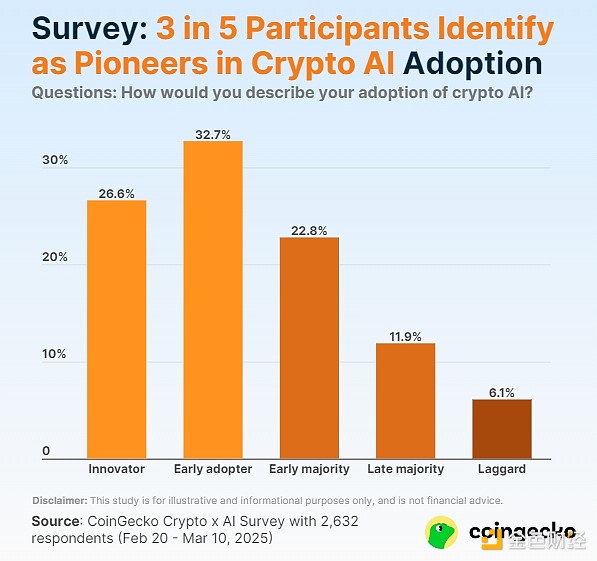Source: Coingecko; Compiled by: Deng Tong, Golden Finance
How widespread will the adoption of crypto AI be in 2025?
In a survey conducted this year, 59.3% (nearly three-fifths) of cryptocurrency participants considered themselves to be among the first adopters of crypto AI.Another 34.7% of participants considered themselves to be in the mainstream of crypto AI adoption, while the remaining 6.1% of participants expressed doubts and were the least willing to adopt crypto AI.
Compared to the bell curve distribution that technology adoption usually follows, the proportion of first adopters of crypto AI is unusually high. This can be attributed to the self-selection bias of participants who are already interested in crypto AI, but it may also indicate that the adoption of crypto AI is still dominated by technology enthusiasts and has not yet gained mainstream attention even within the crypto industry.

Among the pioneers of crypto AI adoption, 26.6% of participants self-identified as "innovators" or technology enthusiasts who are keen to follow any new trends, and 32.7% of participants self-identified as trend-sensitive "early adopters". The increase in the proportion of "early adopters" may reflect the latest cognitive shift, with the crypto industry increasingly viewing crypto AI as a promising key area rather than just hype.
Meanwhile, 22.8% of crypto participants consider themselves to be the “early majority” in crypto AI adoption, almost double the 11.9% who consider themselves to be the “late majority”. This suggests that the challenge currently facing crypto AI is how to promote its adoption among a more practice-oriented, risk-averse mainstream population. In order for crypto AI projects to be adopted by the “early majority” first, they may need to clearly demonstrate how they solve real problems or create value for users.
Finally, a minority of 6.1% consider themselves to be “laggards” who are skeptical and resistant to change, which is consistent with the tail end of the typical bell curve distribution. These “laggards” may be a combination of realists (who are only interested in participating in crypto AI for monetary gain), AI critics, and cautious users waiting for more mature technologies.
More Crypto Newbies Divided on Crypto AI Adoption
Notably, in the first market cycle, 31.5% of participants considered themselves “innovators” in crypto AI adoption, while 7.4% considered themselves “laggards.” Both percentages were higher than those of participants in the second cycle (19.9% of participants considered themselves “innovators” and 4.3% of participants considered themselves “laggards”) and those in the third cycle and above (24.4% of participants considered themselves “innovators” and 5.3% of participants considered themselves “laggards”). This suggests that crypto newbies may have stronger and more divergent views on the interpretation of crypto AI, especially when some of the population may have entered the cryptocurrency field due to the latest crypto AI craze. On the other hand, participants who have experienced the second round of crypto cycles and veterans have similar distributions of adoption attitudes towards crypto AI. The only difference is that the second round participants have a slightly higher proportion of the “early majority” group, while veterans have a higher proportion of the “innovators” group.
Crypto AI Adoption Curve in 2025
The crypto market’s interest or attitude towards adopting crypto AI is distributed as follows:

 Weatherly
Weatherly






